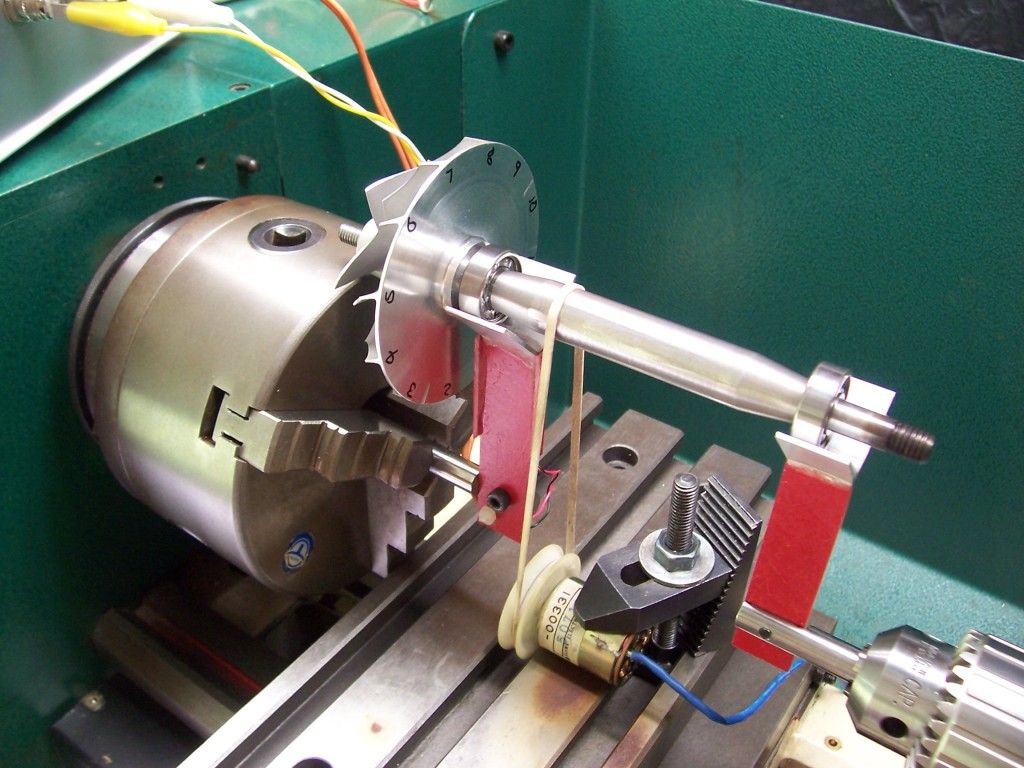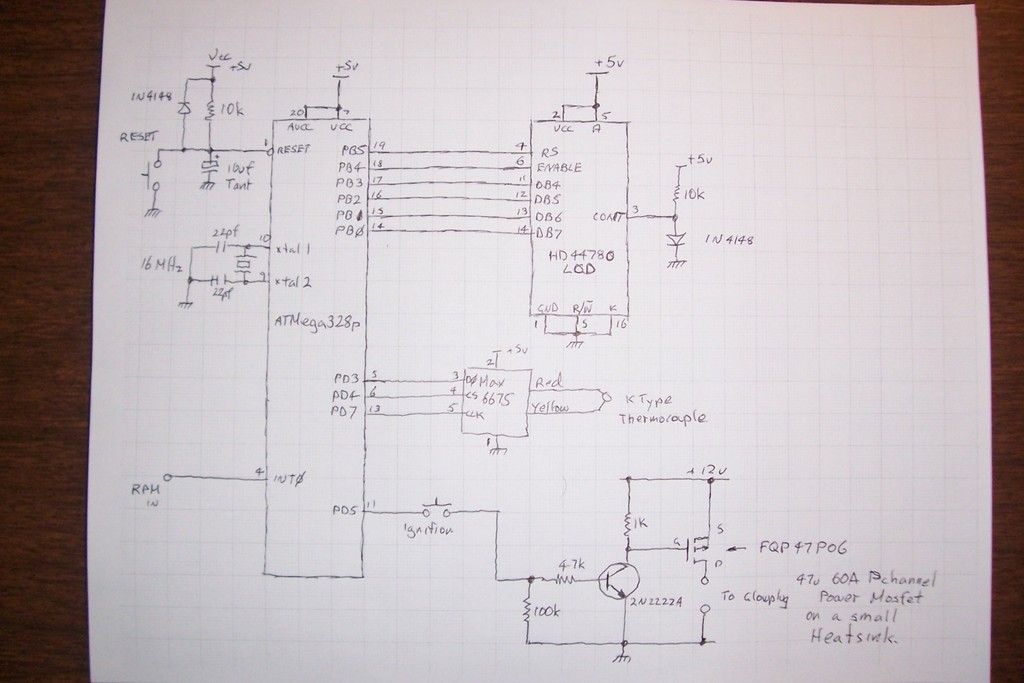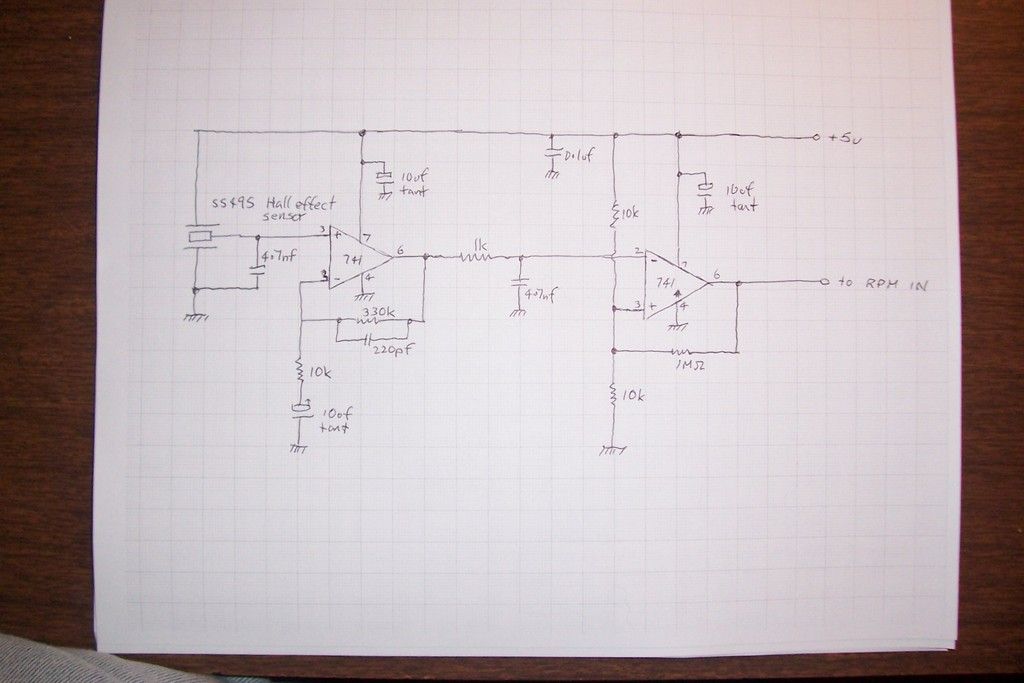First off, what a great accomplishment on the turbine!
Thanks Peter, much appreciated.
- when you detect an imbalance, how do you then go back to the appropriate (radial) position in order to alter the mass at the right spot? Do you orient or register the shaft assembly in some manner beforehand somehow?
I will attempt to explain how this is done.
As you probably can see from the photos previously posted, the balancing rig consists of two fiberglass arms one of which has a piezo sensor attached. The electronics consists of a piezo signal amplifier with 6 sensitivity settings, a zero crossing detector, and a strobe circuit. There is also a variable DC power supply used as a speed control for the motor that spins the rotor under test. The balancer is equipped with a meter that measures the amount of imbalance detected by the sensor.
A typical balancing session session starts by spinning the rotor in the rig, increasing the speed of rotation until a resonance point is reached, the resonance point is indicated by a peaking of the signal observed on the meter and the stability of the static image of the rotor created by the strobe. The wheel to be balanced will have previously been marked at regular intervals around its circumference. Here is a photo of the compressor wheel with a set of markings.
Once the resonance speed has been determined, the speed of the rotor is not changed for the rest of the procedure.
At this point we don't know where the imbalance point is. In order to locate it an additional weight is introduced, usually by adding a small amount of putty or plasticine to the wheel in an arbitrary location. If the position of the additional weight does not coincide with the imbalance point the static image generated by the strobe will shift either to the left or the right. The number at the top of the wheel is noted, the test weight is moved 90 degrees and the test repeated and the new number at the top of the wheel noted. This test is repeated twice more so that the test weight has been tried at 4 cardinal points around the wheel and the four resulting strobe numbers noted. These four strobe points will typically all be on one side of the wheel, the center of these strobe points will be very close to the actual imbalance in the wheel. The test weight is now placed at this center point and the strobe image shift is compared to the strobe image when the weight is removed, by moving the test weight left or right in small increments it should be possible to find a location where the strobe image no longer shifts when the weight is added or removed, this is the imbalance point.
To determine how much material to remove the test weight is moved 180 degrees from the heavy point, more putty is added (or removed) until the signal strength on the meter drops to zero. Material can now be ground off the heavy point in very small increments, and a corresponding amount of putty removed to re-balance, this is repeated till no putty remains and the wheel should theoretically be in balance. All of the above assumes that there is only one heavy point on the wheel, this is often not the case, smaller imbalance points often exist, if so, the whole procedure is repeated at a higher sensitivity setting on the piezo amplifier.
- would this balancer be confined to reletively small amounts of imbalance like your turbine & teeny manufacturing differences, or could it somehow be adapted to typical combustion engines to tune crankshaft counterweight running assemblies?
It might be possible to adapt it to crankshaft balancing, I think it would be a matter of setting the right amount of sensitivity in the amplifier and finding an appropriate resonance speed.
- is the rpm level itself somthing that factors into correcting balance, or do you arrive at the same correction recipie by just spinning it at some safe, arbitray rotation amount?
The rpm used on the balancer is determined by the natural resonance of the rotor and the sensor arms. This is the point that the rig produces the best signal for the balancer electronics.
Disclaimer !
There are probably other and better ways to balance these rotors, I'm no expert, this is just one method. ;D
Again, thanks to everyone for all the kind words and hopefully my explanations are clear enough to understand.
Regards,
Steve.






















![DreamPlan Home Design and Landscaping Software Free for Windows [PC Download]](https://m.media-amazon.com/images/I/51kvZH2dVLL._SL500_.jpg)
























![MeshMagic 3D Free 3D Modeling Software [Download]](https://m.media-amazon.com/images/I/B1U+p8ewjGS._SL500_.png)














